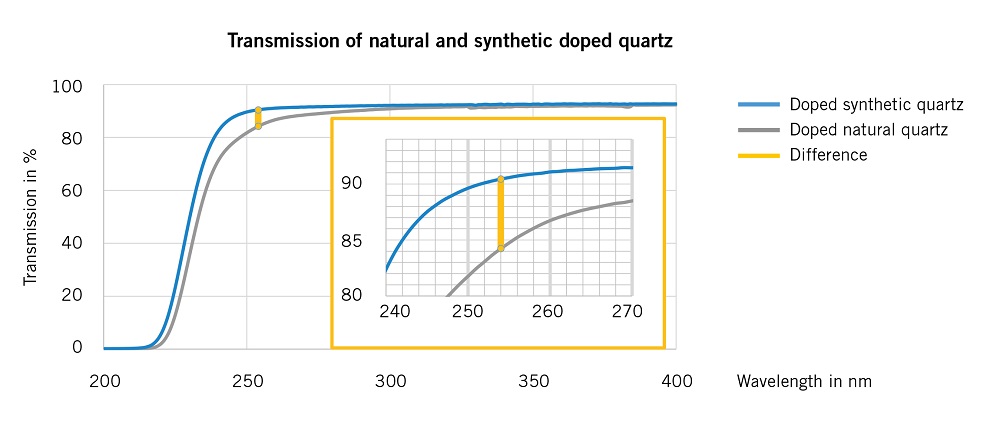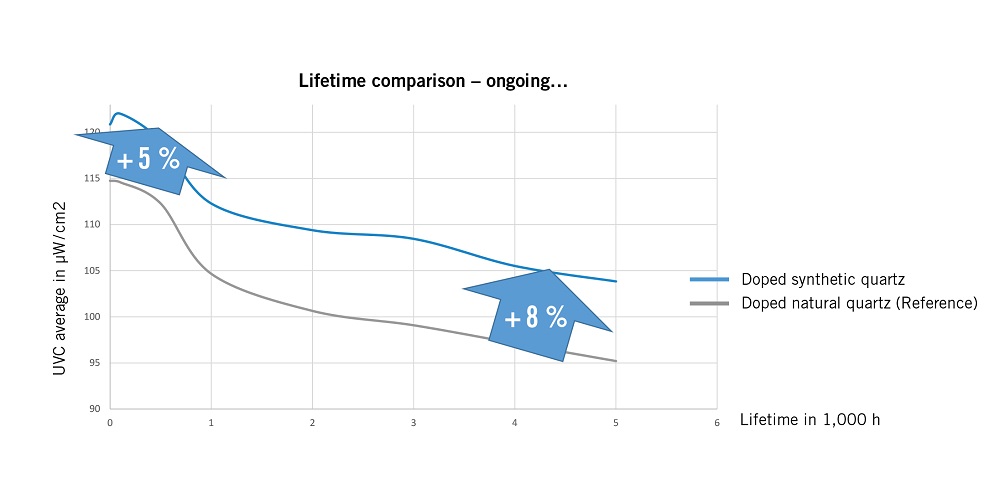Low-pressure mercury lamps are used for many decades in UV disinfection systems for air and water treatment. They are proven as a reliable and cost-effi cient tool across industry and academia. Recent increases in energy prices put a new emphasis on total cost of ownership calculations and will increasingly so in the future. The key for cost effective systems are highly effi cient UV lamps that can reduce operating costs.
Doped Synthetic Quartz for Highly Efficient & Long-life Disinfection Lamps
Background: UV in Desinfection
Idea
1. Idea: Upgrade from Natural to Synthetic Quartz

We investigated upgrading the quartz glass quality from doped natural to doped synthetic quartz glass, to increase UV output at end of lamp life (EOLL), and the corresponding lamp efficiency. The key advantage is the higher transmission of doped synthetic quartz at 254 nm compared to natural quartz, which is affected by structural impurities in the bulk.
Over lifetime, the mechanisms of further defect formation are stronger in natural quartz (e.g. E’ formation of color centers at 215 nm with a wide effecting wavelength width), Advantageously, synthetic quartz is effected less, and it even recovers from initial, smaller E’ defects (215 nm) and non-bridging oxygen hole center formation (NBOH at 265 nm). This suggests a less intense degradation over lifetime for synthetic quartz. These improvements are accompanied by high-quality long-lifetime coatings to boost the overall result.
This results in a higher UV quantum yield for each lamp with less radiation losses in the quartz glass.
The solution is valid for the full power range of low-pressure UV lamps up to 1,500 W.
Benefits
2. Benefits: Higher Efficiency and EOLL

Latest lifetime data of the UV output in direct comparison of both lamp types suggest an
- Increase in efficiency at 100 h up to +5%, and
- Increase in UVC in the end of lamp life (EOLL) up to + 8%
All lamps are driven with the identical electrical power supply with the same input power.

Total Costs of Ownership
3. Total Costs of Ownership
Over lifetime the usable UV output increases by appr. 5%. At the same time, the overdose in the beginning of lifetime decreases. The total usable UV dose per lamp increases (are in the plot):

Higher material cost of purer synthetic quartz glass can be overcompensated by energy savings. This leads to lower total costs of ownership by energy savings, reduced number of bulbs in reactor design and less service cost due to longer lifetime.

Summary
4. Summary
To improve the long established reliable and cost-effi cient UV disinfection systems with low-pressure mercury lamps, we propose a shift from doped natural to doped synthetic quartz.
The key for cost effective systems are highly effi cient UV lamps that can reduceoperating costs. The use of synthetic quartz results in a higher UV quantum yield compared to standard natural quartz. Different mechanisms on defect formation in both quartz glass types result in even increasing advances for synthetic quartz over lifetime. Thus, the higher material costs can be overcompensated by a higher UVC yield.
This leads to lower total costs of ownership by energy savings, reduced number of bulbs in reactor design and less service cost due to longer lifetime for the full power range of low-pressure UV lamps up to 1,500 W.
Questions? Contact us!:
More Information


